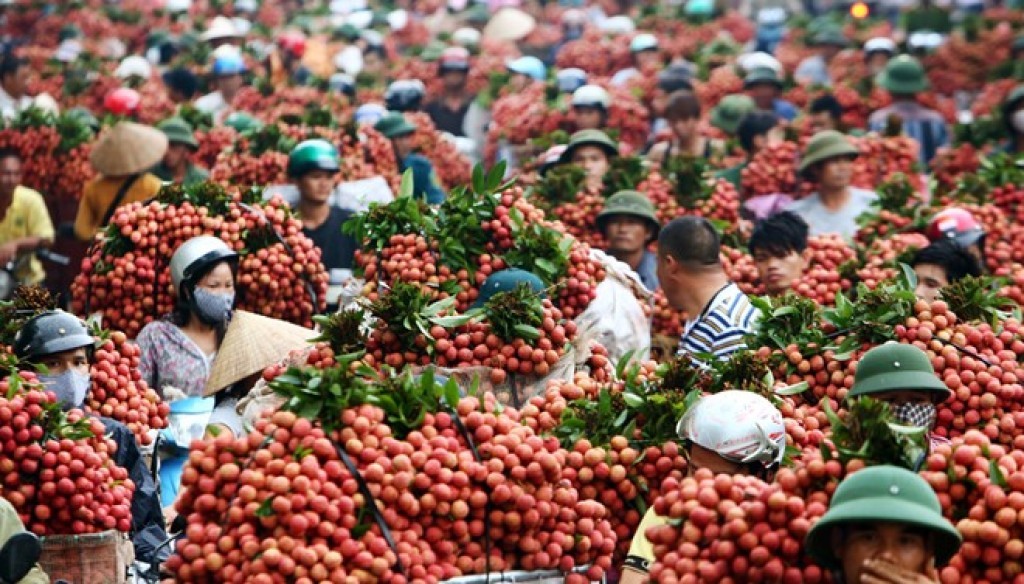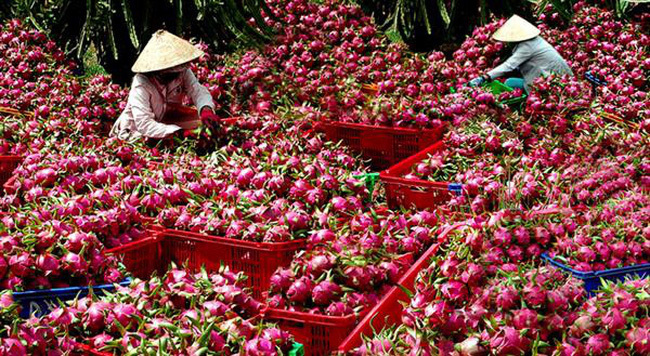5 YEARS OF CHALLENGING TO COME TO JAPAN, 10 LONG YEARS TO GO TO THE DOOR OF THE US
01 Mon, 2020
The fastidious market simultaneously issued a "visa" for Vietnamese fruits


In 2019, Bac Giang lychee suffered a crop failure, the output decreased by nearly half compared to 2018. However, thanks to good marketing, export to even fastidious markets, farmers in Luc Ngan (Bac Giang) still have a good harvest. Accordingly, at the end of the lychee season, people here earned 6,300 billion VND, an increase of more than 500 billion VND compared to the previous year.
In the last days of the year, lychee growers across the country in general and Luc Ngan in particular welcomed a new good news: Vietnam lychee was officially exported to Japan. After the US, EU, Australia, Canada, ... Vietnam lychee continues to affirm its prestige and quality in the most demanding market in the world that is Japan, creating more opportunities to export, high income for lychee farmers.
This is the result of more than 5 years of negotiation efforts between Plant Protection Department (Plant Protection) and MAFF, and many rigorous experiments are conducted to ensure the thorough eradication of Japanese plant quarantine objects which is likely to follow Vietnam's lychee fruit.

Vietnam lychee is officially exported to Japan after 5 years of negotiation
Phytosanitary requirements for Vietnamese lychee exported to Japan include: lychee must be grown in gardens that are inspected, supervised and granted by the Plant Protection Department, meeting the regulations on plant quarantine and food safety of Japan; Exported lychee lots must be packed and treated with fumigation with Methyl Bromide at facilities recognized by Plant Protection Department and MAFF with a minimum dosage of 32g / m3 for two hours under the supervision of the officers of plant quarantine of Vietnam and Japan; lots of lychee exported must be accompanied by a Phytosanitary Certificate issued by Plant Protection Department.
Mr. Le Son Ha - Head of Plant Quarantine Department (Plant Protection Department) - said, although Vietnamese lychee has entered many difficult markets, ... but if the US market, Australia only requires irradiation then Japan requires steam disinfection treatment.
“It took us more than 2 years of conducting a fumigation experiment to thoroughly eradicate plant quarantine objects that could follow lychee. In the end, Japanese experts came to check it directly and approved, ”Mr. Ha said. This is a new breakthrough, the first time we do fumigation and have been accepted by the Japanese market.
This success is not only for lychee, but also a precondition for other fruits to be exported to Japan, even Korea. Because the two countries only accept fumigation, not irradiation, Mr. Ha said.
Looking back at 2019, despite many difficulties, but this is also a year of effort when Vietnamese fruits penetrate into a series of difficult markets in the world.
For example, in the middle of February this year, Vietnamese mangoes were officially granted a "visa" to the US after a 10-year journey of negotiation efforts, after lychee, longan, rambutan, star apple, dragon fruit. The US has also become the 40th export market of Vietnamese mangoes.
Similarly, after a long negotiation, at the end of August this year, the Ministry of Agriculture and Water Resources of Australia allowed Vietnam's fresh longan to be officially exported to this country. Longan is the fourth fruit allowed to export to Australia after passing many quality control standards. At the same time, Chile also allowed Vietnamese mangoes to be exported to Chile.
Earlier, mangosteen is also the 9th fruit of our country to be officially exported to the market of 1.4 billion Chinese people.
Affirming the quality of Vietnamese fruits
According to Mr. Le Son Ha, the fact that Vietnam's main fruits open the door of fastidious markets such as Japan, Korea, USA, Australia, EU, New Zealand, ... has great significance, In addition to affirming the prestige of Vietnamese fresh fruits, it also helps to raise export value, creating a premise to promote the production of high quality goods.
“Vietnamese fruits are almost exported to all countries. The fruits with great export potential of Vietnam have so far penetrated most of the most difficult markets in the world, ”Mr. Ha affirmed. At present, the amount of fruits exported to the fastidious market accounts for more than 30%, including very good growth markets such as the US, South Korea, Australia, Canada, ...

Vietnam has a great potential for export fruits as the market expands
However, Mr. Ha said that the right thing to do is to expand the scale of production, businesses better organize exports. In particular, how to make Vietnamese fruit come to consumers must be of the best quality and best price.
In fact, there have been competing partners like Cambodia, like their mangoes, also exporting to the difficult Korean market. Or China has expanded its dragon fruit growing area, .... If we don't change it will be difficult sometime.
In addition to the quality factor, ensuring food hygiene and safety requires farmers to produce goods on a large scale to meet the large orders of importers - this is still a difficult problem for the fruit industry in our country.
Therefore, according to Mr. Ha, in production must be linked. We often say vertical link "6 houses". This is a good way, but it is still necessary to do cross-linking, that is, farmers link together to form large-scale planting areas, thereby creating good and uniform quality products.
Our country has a relatively large Luc Ngan lychee area, Binh Thuan dragon fruit makes a very good link, creating products that ensure the volume and uniform quality, meeting the most demanding markets.
The next year, the agricultural sector recalculates export efficiency in each market, focusing on high-performing areas. In particular, priority for the Chinese market due to the advantage of transportation almost by road and air, rail and waterway. At this point, we will negotiate for durian fruit to be officially exported to China, in addition to some other fruits to open up more difficult markets.
According to a report of the Department of Agro-product Processing and Market Development (Ministry of Agriculture and Rural Development), in the first 11 months of 2019, Vietnam's vegetable and fruit export reached US $ 3.5 billion, down 0.6% over the same period of last year. A slight decrease in quantity but a great change in quality creates a sustainable path for Vietnamese fruits.
Specifically, although the export of fruits and vegetables to the Chinese market decreased by 13.7%, the export value to fastidious markets in return increased sharply. For example, fruit and vegetable export to the US reached 124.6 million USD, up 10.7%; South Korea reached 107.4 million USD, up 12.3%; Japan reached 100.7 million USD, up 12.6%, ... compared to the same period in 2018. In addition, some markets with strong export value of vegetables and fruits such as Laos (5.17 times). , Hong Kong (3.12 times), Taiwan (up 66.6%), Netherlands 36.6%.
Source: https://vietnamnet.vn
Related Post
The true fishmeal carbon footprint
The established Life Cycle Analysis (LCA) methodology to assess the fishmeal carbon footprint only accounts for the vessel fuel and post-harvest processing energy while ignoring the carbon sequestration potential of fish.
View more
Freezing Tropical Fruits: Convenient and Effective Solution with Octofrost Machines
Tropical fruits are always a great choice for providing nutrition and fresh flavor to daily meals.
View more


